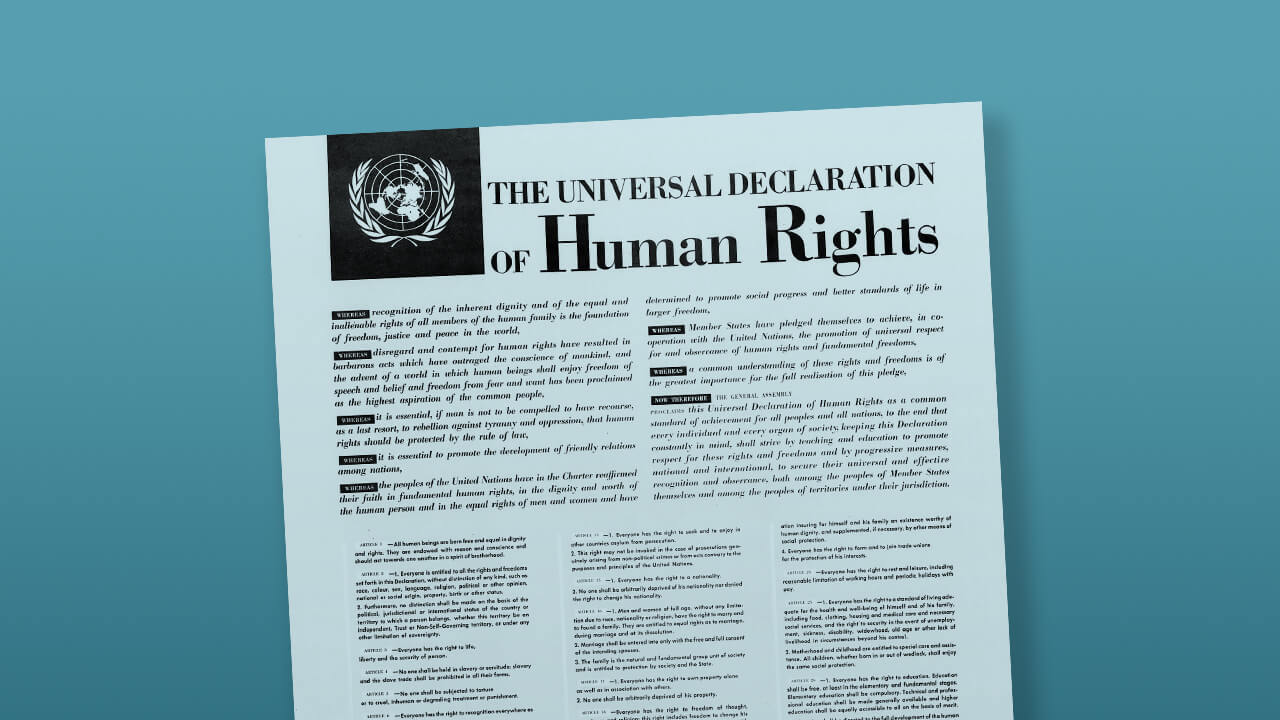Human Dignity and the Universal Declaration of Human Rights

The United Nations was founded in October 1945. Eight months later, it established a Commission on Human Rights, which was given the task of producing an international “bill of rights.” The resulting document—the outcome of two years of discussion, drafting, revision, and gradual agreement on the part of UN members representing eighteen nations with often sharply divergent political traditions and viewpoints—was the Universal Declaration of Human Rights (UDHR), ratified on December 10, 1948.
Despite their political differences, what above all kept Commission members devoted to their common purpose was knowledge of the barbarisms and massacres committed during the Second World War, and shock over the discovery of Nazi death camps: systematized atrocities constructed on the premise that some races, some ethnic groups, some nationalities, some persons of this or that condition or persuasion were not genuinely human, but rather subhuman beings, who should be exterminated. More than any other factor, the extermination camps brought the Commission’s members into solidarity in the conviction that, as representatives of the world community, they were morally required to articulate and promulgate a universal code of human rights as an expression of world conscience in response to such atrocities.
It was clear from the outset, however, that given the diverse political visions and principles represented within the Committee’s membership, its international bill of rights would have to employ a language that was pragmatic rather than theoretical: that is, a language that avoided all metaphysical and religious formulations. Common agreement on the ontological (metaphysical) basis of human rights was out of the question.
This explains the purely secular character of the UDHR. Even an unprovocative reference in Article 1 to “nature” as the source of human reason and conscience, present through most of the drafts, was finally deleted primarily because it was deemed by objectors to carry the hint of the Enlightenment idea of Nature as the creation of God. The document ultimately ratified was one that, as the French delegate and key drafter René Cassin stated, “allowed the Committee to take no position on the nature of man and of society and to avoid metaphysical controversies, notably the conflicting doctrines of spiritualists, rationalists, and materialists regarding the origin of the rights of man.”
Still, the drafters of document had to give some indication as to why it is that human beings have what is identified as “inalienable rights,” including rights to life, liberty, security; to ownership of property; to equal recognition and obligation under law; to legal protection against discrimination; and to freedoms of expression, religious worship, association, and other freedoms. What is the basis for asserting that human beings have rights?
The preclusion of any religious or metaphysical answer meant that the drafters could not have recourse to the idea, proclaimed by the U.S. Declaration of Independence, that persons are endowed by a Creator with certain “unalienable rights.” Nor could they allow inalienable rights to derive from the state, or any other social organ, since something socially conferred can, on principle, be socially rescinded.
The drafters solved this problem by indicating that human beings have rights because of their inherent dignity—because human beings, due to qualities they possess (i.e., due to human nature)—have a special value, a distinctive worth, that in each case and without exception should be respected and nourished. Thus the UDHR’s first words proclaim the “inherent dignity” of each member of the human family.
This relationship of rights deriving from dignity is not, it is true, what the opening clause of the UDHR’s Preamble states. It simply affirms, first, a fact of “human dignity,” and then a fact of “human rights,” and does not assert the dependence of the latter on the former. It reads: “Whereas recognition of the inherent dignity and of the equal and inalienable rights of all members of the human family is the foundation of freedom, justice and peace in the world—”
One might reasonably question, then, a claim that the document presents human dignity as the basis of human rights.
But it turns out that the claim is supported by considerable evidence.
Records available to anyone wishing to examine the history of the composition of the UDHR reveal that three of the four Committee members most influential in its ultimate shaping—the Lebanese delegate Charles Malik, the U.S. delegate Eleanor Roosevelt, and the Chinese delegate P. C. Chang—understood the relation between dignity and rights precisely in this way. (The fourth key shaper was the French delegate, René Cassin.)
A few pieces of evidence:
First, at the first official meeting of the Human Rights Commission in January 1947, Chang suggested—among general agreement—that the UDHR should include a preamble that set forth the premises on which the document’s assertion of rights was based, and that the concept of human dignity should be elevated for just that purpose.
Then, in June 1948, when the South African delegate C. T. Te Water suggested removing the term dignity from the document altogether (a telling signal of apartheid-based politics), Eleanor Roosevelt responded by explaining that in the scheme of the document, Article 1—which affirms universal, equal, and inherent human dignity—“did not refer to [any] specific rights because it was meant to explain why human beings have rights to begin with” (my emphasis).
Finally, in June 1948, when Malik—a philosopher—composed the final version of the Preamble, he made sure that the very first words of the document affirmed “inherent dignity” with the explicit intention, he said, of indicating why human beings have rights.
There are a number of later UN documents that make this reasoning explicit. Perhaps most notable are the two “International Covenants” on Civil and Political Rights, and on Economic, Social and Cultural Rights (1966), and the 1975 Convention Against Torture. All three documents begin with the assertion that human rights “derive from the inherent dignity of the human person.”
The Helsinki Final Act of 1975 reaffirms this deriving of rights from dignity, as does the Vienna Declaration adopted by the World Conference on Human Rights in 1993.
Inherent human dignity is thus, beyond doubt, the founding fact upon which rests the affirmation of human rights in the UDHR.
The reason why clarifying this is so important, is the enormity of the influence of the UDHR. Its understanding of dignity’s relation to rights has been echoed in many charters, conventions, and constitutions produced around the world since 1948: for example, in the Basic Law for the Federal Republic of Germany (1949), whose famous first words are: “Human dignity shall be inviolable. To respect and protect it shall be the duty of all state authority”; and in the post-apartheid Constitution of the Republic of South Africa (1996), which pronounces the nation to be founded on “unalterable” values, the first of which is “human dignity.”
The extraordinary impact of the UDHR through (and then radiating beyond) political documents is, in fact, one reason why references to human dignity have become so ubiquitous among not only politicians and legalists, but in journalism and among the general population. The ratification and promulgation of the UDHR turns out to have been a kind of “moment zero” in which the concept of inherent human dignity began to be propelled to the center of everyday political and cultural discourse (though it had long been a staple of philosophical, theological, and political writings).
One might wonder, though, how often everyday moralists who nowadays use the term dignity (referring to “inherent dignity”) have a clear grasp of the meaning of the concept—not to mention its metaphysical implications.
Freighted language symbols such as inherent dignity, after all, arise from and are meant to convey specific insights—insights in which specific intelligibilities have been grasped in the course of striving to understand certain experiences.
So: which intelligibilities? What experiences? The key drafters of the UDHR will have had answers to those questions, even if they could not state them in the document.




